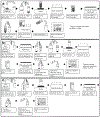Evaluation of sample processing methods to improve the detection of Bacillus anthracis in difficult sample matrices
- PMID: 36104633
- PMCID: PMC10410253
- DOI: 10.1007/s10661-022-10467-0
Evaluation of sample processing methods to improve the detection of Bacillus anthracis in difficult sample matrices
Abstract
Large area sampling approaches have been developed and implemented by the US Environmental Protection Agency (EPA) to increase sample sizes, and potentially representativeness, in outdoor urban environments (e.g., concrete, asphalt, grass/landscaping). These sampling approaches could be implemented in response to an outdoor biological contamination incident or bioterrorism attack to determine the extent of contamination and for clearance following remediation. However, sample collection over large areas often contains an extensive amount of co-collected debris and native background microorganisms that interfere with the detection of biological threat agents. Sample processing methods that utilize basic laboratory equipment amenable to field deployment were selected and applied to turbid aqueous samples (TAS) to reduce particulates and native environmental organisms prior to culture and rapid viability-polymerase chain reaction (RV-PCR) analytical methods. Bacillus anthracis Sterne (BaS) spores were spiked into TAS collected by soil grab, wet vacuum collection from an outdoor concrete surface, or storm water runoff from an urban parking lot. The implementation of a sample processing method improved the sensitivity of culture and RV-PCR analytical methods for BaS spore detection in soil and wet vacuum TAS samples compared to baseline (minimal to no field processing methods applied). For soil, when the processing method was applied, samples with 15 colony forming units (CFU)/ml (60 CFU/g) and 1.5 CFU/mL (6 CFU/g) BaS spore load were detected using culture and RV-PCR, respectively. Most notably, the processing methods greatly improved the sensitivity of the RV-PCR analytical method for the wet vacuum TAS from no detection at the 1500 CFU/mL BaS spore load level to as low as 1.5 CFU/mL BaS spore load.
Keywords: Bacillus anthracis; Rapid viability-polymerase chain reaction; Soil samples; Storm water runoff samples; Surface sampling; Wet vacuum samples.
© 2022. This is a U.S. Government work and not under copyright protection in the US; foreign copyright protection may apply.
Conflict of interest statement
Figures





References
-
- Calfee MW, Rose LJ, Morse S, Mattorano D, Clayton M, Touati A, Griffin-Gatchalian N, Slone C, & McSweeney N (2013). Comparative evaluation of vacuum-based surface sampling methods for collection of Bacillus spores. Journal of Microbiological Methods, 95(3), 389–396. 10.1016/j.mimet.2013.10.015 - DOI - PMC - PubMed
-
- Griffin DW, Lisle JT, Feldhake D, & Silvestri EE (2019). Colony-forming unit spreadplate assay versus liquid culture enrichment-polymerase chain reaction assay for the detection of Bacillus endospores in soils. Geosciences, 10(1), 5. Retrieved June 5, 2022, from https://www.ncbi.nlm.nih.gov/pmc/articles/PMC7784721/pdf/nihms-1651953.pdf - PMC - PubMed
-
- Lee SD (2018). Evaluation of commercial wet vacuums for anthrax sampling. U.S. Environmental Protection Agency, Washington, DC, EPA/600/R-18/158. Retrieved June 5, 2022, from https://cfpub.epa.gov/si/si_public_record_report.cfm?dirEntryId=341891&L...
MeSH terms
Substances
Grants and funding
LinkOut - more resources
Full Text Sources
Research Materials

